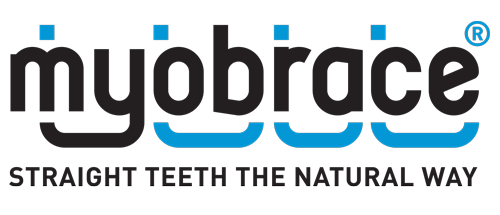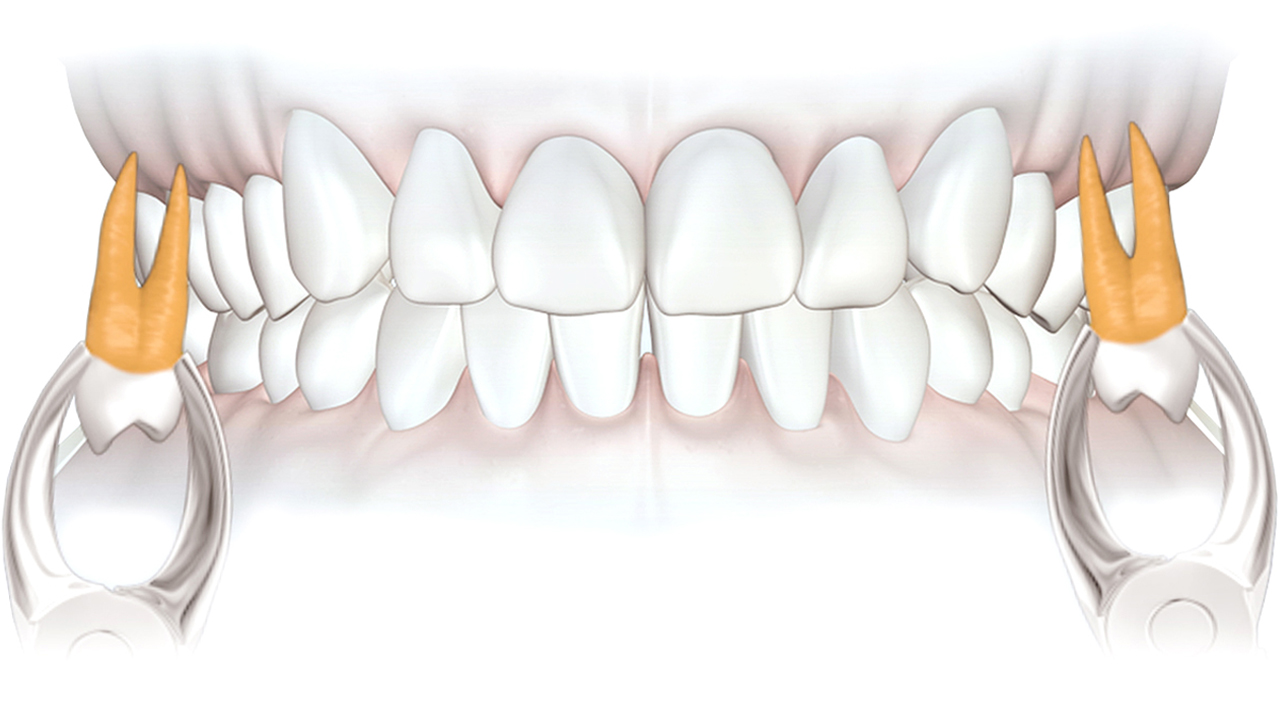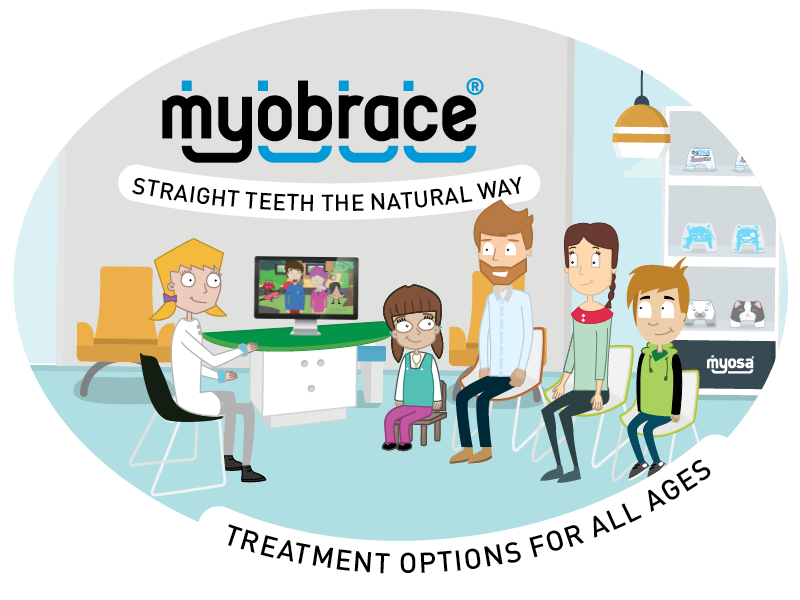
An Overview
Did you know that four out of five children will develop crooked teeth, which is evident from as early as five years of age? The longer you wait to treat these orthodontic and health issues, the bigger the problem gets over time.
Hereditary factors are often considered to be the main cause, however, rather than blame genetics, modern research points to other causes. Incorrect myofunctional ('myo' meaning muscle) habits, such as mouth breathing, tongue thrusting, incorrectly swallowing and thumb sucking, are now recognised as the causes of poor jaw development and crooked teeth.
Myobrace® is early orthodontic treatment that focuses on addressing the underlying causes of crooked teeth, often without the need for braces. This allows for natural growth and development of the jaws to occur so that children are able to grow to their full genetic potential. Treatment is best suited to children aged 3 to 15 and involves using a series of simple and effective removable oral appliances worn for only one to two hours each day, plus overnight while sleeping.
Myobrace® treatment offers a range of benefits including:

The Causes of Crooked Teeth
Hereditary factors or big teeth in small jaws are not responsible for crowded teeth or incorrect jaw development. The real culprits are things like mouth breathing, tongue thrusting, incorrectly swallowing and thumb sucking, which are known as incorrect myofunctional habits. As children are growing, if the muscles are continually used the wrong way and push on the teeth and jaws incorrectly, these forces restrict and negatively influence jaw development.
Mouth breathing causes a domino effect. As the mouth opens, the tongue drops down away from the roof of the mouth. As it is the tongue that determines the shape and size of the upper jaw, incorrect resting position of the tongue leads to jaws that become too small and narrow.
The surrounding muscles of the lips and cheeks can also then learn to compensate for this incorrect tongue position, causing an incorrect swallowing habit. The forces of these muscles pushing against the jaws restrict full growth from occurring. It is not a case of the teeth being too big, but because the jaws have not been able to develop sufficiently.
Traditional orthodontics tries to solve this problem by mechanically aligning teeth in the undersized jaws, sometimes leading to the removal of healthy adult teeth in an attempt to gain sufficient space to do this.
With lack of space for the tongue to rest comfortably up on the roof of the mouth, it can instead become weak and fall into and take up space in the airway as you sleep, causing snoring and a range of other sleep-related breathing dysfunctions to occur.

The medical profession now recognises that mouth breathing and undersized jaws are the main contributors of Sleep-Related Breathing Disorders (SRBD). Symptoms include snoring, teeth grinding, morning tiredness and learning difficulties, with extreme cases stopping breathing at times during the night. If left untreated, significant and serious health problems can develop over time.
Symptoms commonly associated with SRBD can include:
How Treatment Works
Poor myofunctional habits are evident long before all permanent teeth are present, which means that treatment of the causes can begin much earlier than originally thought, sometimes as early as three years of age. Waiting until all permanent teeth have come through to begin treatment with braces can unfortunately lead to irreversible damage affecting not only the teeth, but also facial development and overall health.
Myobrace® treatment goes beyond what braces alone can offer as it focuses on correcting the poor breathing and oral habits responsible for poor development, allowing the jaws and teeth to naturally become straighter as the facial structure is able to develop properly.
Treatment consists of wearing a series of simple and effective removable Myobrace® appliances, which are worn for only one to two hours each day and overnight while sleeping.
The appliances incorporate specific design features for retraining poor oral muscle habits, while also exerting light forces to align teeth and widen the jaws so they can grow to their full and intended size. There are many variations of the Myobrace® appliance, which are prescribed by the practitioner based on the patient's age and specific needs.
In addition, patients undergo a specialised breathing and oral muscle exercise program, known as the Myobrace®Activities. Taught by our friendly team of educators, the program helps patients to understand how to change their habits in a fun and easy to comprehend way. The activities further assist in correcting poor myofunctional habits while also offering long-lasting benefits by teaching patients to habitually:
As well as aligning the teeth, jaws and improving facial development, Myobrace® treatment can provide additional health benefits by addressing a range of issues related to breathing disorders. In children, breathing disorders are linked to TMJ (jaw joint) problems, restless sleep, daytime sleepiness, hyperactivity, teeth grinding, bedwetting, and more. Adults with breathing disorders also have a higher risk of fatigue, cardiovascular disease, mental health issues, and the list goes on. More information about breathing disorders and treatment options can be found in the What is Myosa®? section of this website.
For more information about Myobrace® treatment, including proven results, self evaluation, the research and much more, visit myobrace.com
It is not always possible to achieve all of these goals. Success of treatment is heavily dependent on the patient's commitment to daily use of the appliances and prescribed exercises, their biological ability to change habits, as well as stage of development. Generally, the earlier treatment is started, the faster and higher the level of success is able to be achieved. Good compliance allows for the best results in growing children aged 3-15 years.
When to Start Treatment
While traditional orthodontic treatment with braces or aligners usually commences once all the adult teeth have come through, Myobrace® treatment takes a preventative approach, so can start much sooner, ideally while the teeth and jaws are still growing.
Myobrace® treatment is suitable for children aged 5 to 15, but is generally most effective between 6 to 10 years of age. This is because children in this age bracket are still developing and growing. Although Myobrace® is best suited for children, treatment for adults is also available and can offer a range of health benefits in addition to just straightening your teeth.
Book your free consultation today to find out more about Myobrace® treatment or visit myobrace.com!

For patients with an underlying airway or breathing related issue, Myosa® treatment may be an option prescribed by the practitioner. More information about Myosa® can be found on the Myosa® section of this website.
The Myobrace Centre
Coupled with a modern approach to treatment, the overall experience at the Myobrace® Centre located at Helensvale on the beautiful Gold Coast is quite different to your typical dental practice. Rather than in a dental chair, patients spend most of their appointment learning and practising exercises in the activities area.
Custom artwork throughout the spacious centre create a motivating and engaging learning environment far from sterile, combining this with interactive touchscreens as teaching aids, patients are given the best opportunity to help them reach their treatment goals.
Purpose-built consultation rooms allow patients and their families to learn about treatment and be updated on their progress while, in the treatment rooms, intimidating dental equipment is kept out of sight and themed graphics cover the walls to create a relaxed environment.
The Myobrace® Centre team is headed by the founder of Myobrace® treatment, Dr Chris Farrell. His highly skilled team of dental professionals are trained in traditional orthodontic techniques including braces, aligners and arch expansion, as well as myofunctional therapy, myofunctional appliances, treatment for temporomandibular disorders (TMD), and sleep dentistry. They have also taught this modern approach to practitioners all around the world, now used in over 100 countries worldwide.
At the Myobrace® Centre, you can be assured that you're in capable hands.
If you are wanting a more natural approach to straight teeth, Myobrace® may just be the solution you’ve been looking for!
Patient Questionnaire
If you are considering on booking a free consultation, please complete our brief questionnaire prior to attending your appointment. This will allow the consulting practitioner a have greater understanding of your concerns and ensure you get the most out of your visit. The questionnaire is a PDF download and can be emailed to clinic@myobrace.com prior to your appointment. Alternatively, please bring a printed copy to your consultation.
For more information about Myobrace® or Myosa® treatment options, book in for a no obligation free consultation or call us today!